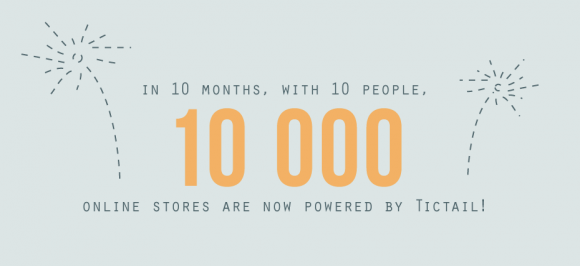
Editor’s note: This article by Greg Anderson originally appeared on ArcticStartup, an independent tech blog that reports on digital startups and growth entrepreneurship from the Nordic and Baltic countries.
Today, Stockholm, Sweden-based Tictail became a story of tens.
They’ve hit 10,000 stores after 10 months, and now have ten employees on their payroll. This growth is a sign that their hypothesis of becoming the “Tumblr of e-commerce” is working for them by making their platform completely free to use, beautiful, and dead simple to set up.
“We’re not talking registered accounts, we’re talking real online stores,” says Carl Waldekranz, CEO of Tictail. “We also just brought out an interesting figure here. In the first quarter of 2013 our stores have sold as much as they did in the entire of 2012. And the thing to remember here is that is including the Christmas sales of 2012.”
Waldekranz tells us the transaction distribution of these stores is as expected, with a power-curve, with some stores generating a massive amount of transactions while others are just selling here and there.
This huge growth in sales is fantastic news for the e-commerce platform, the number of stores is actually the interesting metric to follow. Unlike Shopify or other competitors, Tictail doesn’t take a cut of transactions. Instead the company monetizes (or will monetize) off of the ‘Apps’ store owners can add to their stores.
Currently these apps are free until the end of April, and include the ability to add discounts using a coupon code, invoicing, store password protection (so you can sell just to certain people), and the ability put Tictail on a custom domain.
Waldekranz tells us more apps are following in a few weeks – as soon as their developers finish building the app payment engine. In the future, independent developers will have access to Tictail’s API so they can build their own e-commerce apps that that will allow store owners to add even more functionality to their store’s page, and then sell them to other store owners.
Ahead of those apps, Tictail is shooting for global expansion, as well as a new focus on the social aspects of e-commerce, but no hard details are being released about that mechanic at the moment.
Last October Tictail announced €1.2 million in funding in a round led by Balderton Capital and Klaus Hommel. Tictail is a hot product and I’m sure they’re fine on cash, but looking at their model they’ll have to move a lot of apps to get in the green.
But with 10,000 active stores in 10 months, it’s clear the company’s strategy of getting these indie brands and boutiques online seems to be working for them.
Waldekranz tells us: “The cool thing is that if I’m looking at store activity, it’s not only the stores that are transacting that are active on the platform. We see a lot of people that come up with concepts in Tictail that do have some business success, but treat Tictail like their webpage, or their home on the internet.”
Which only means good things for selling more Tictail Apps.
Top image credit: Thinkstock
Get the TNW newsletter
Get the most important tech news in your inbox each week.







